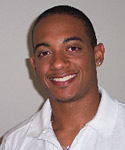About Jacques Courseault, M.D.
 Jacques graduated from Tulane Medical School and has seven years of experience
as a personal trainer. After completing medical school, Dr. Courseault was the Associate Chief Resident specializing in Physical Medicine and Rehabilitation at Louisiana State University. Dr. Courseault continues to promote fitness with the development of LSUHEP.org, which is a home exercise program site for physical ailments.
Jacques graduated from Tulane Medical School and has seven years of experience
as a personal trainer. After completing medical school, Dr. Courseault was the Associate Chief Resident specializing in Physical Medicine and Rehabilitation at Louisiana State University. Dr. Courseault continues to promote fitness with the development of LSUHEP.org, which is a home exercise program site for physical ailments.
After residency, he completed a Sports Medicine Fellowship at Baton Rouge General Hospital while taking care of NCAA athletes as well as local high school athletes. He now is practicing physical medicine and rehabilitation, sports medicine and electromyography at Touro Infirmary in New Orleans, Louisiana.
Exercise Right!
with Jacques Courseault, M.D.
The First Step to Success: Committing to More than Yourself
How to Begin an Exercise Regimen
Walk Your Way to Better Health
How to Begin a Walking Program
Eating and Exercise: What to eat and when
to eat it
Weight, Lean Body Mass and Exercise
Strong Muscles Fight Disease
How to Exercise with Disabled or
Weak Legs
How to Conserve Muscle Mass
During Weight Loss
How to Build Muscle Mass
How to Build Muscular Endurance
Exercise Ideas: Play Video Games!
Exercise Improves Eating Habits
Exercise Right!
Handling Soreness After Exercise

Delayed Onset Muscle Soreness (DOMS) is the ache that you will experience one to three days after beginning a workout program or improving it.
DOMS is the first positive sign of muscle adaptation. During your workout, microscopic tears in muscle fibers occur. Immediately after your workout your body goes to work to repair those torn muscle fibers by increasing their width and adding more individual fibers to the muscle that you exercised. These adaptations allow you to increase your endurance and become stronger. It's important to know the difference between a healthy soreness and soreness that should be of concern.
Workout Burn
This is the burn that you feel during your workout. This healthy burn is caused by lactic acid, which is the byproduct of muscle metabolism. Here's some tips to help your workout:
This burn should only last a few seconds to a few minutes after each set, and can be used as the timer to let you know when to begin the next set.
Good breathing can help reduce the build up of lactic acid, thus allowing you to exercise more.
According to a recent article by researchers at The Mayo Clinic (J Phys 2008, 586: 35-44), your body adapts over time to this burn, and gradually increases the amount of lactic acid that you can handle for each workout you perform.
Delayed Onset Muscle Soreness (DOMS)
The discomfort you may feel from DOMS is less like a burn, and more like an achy, soreness that you will feel 1-3 days after a workout. Here's some ideas to help prevent DOMS:
Take a day off resistance exercise between workouts. That day of rest is absolutely important for muscle recovery and re-growth. You should never workout the same muscle groups on two consecutive days.
Performing FAST PACE or other cardiovascular exercise on your off days is beneficial.
On your next scheduled workout day, perform lightweight workouts if you are still sore.
Interestingly, there's no good research to support any proven benefit of stretching to prevent or relieve DOMS (Cochrane Database 2007, 4).
Musculoskeletal Injury
On rare occasions, severe damage to your muscles, tendons, ligaments or bone can occur, so it's important to be careful and not push yourself too hard. Damage to the musculoskeletal system can cause an excruciating pain to the point where you can no longer use that part of your body to maintain your daily tasks. A musculoskeletal injury can also be associated with an acute pain at the time of injury, a pop that you heard or felt, or a feeling that something tore. You can usually point directly to the area that is giving you the problem.
If the onset is sudden, go to the Emergency Room or to your doctor for evaluation and treatment. In the mean time, rest the injured body part, apply ice (20 minutes on, 20 minutes off) throughout the day, and elevate the painful area above your heart to reduce swelling.
You can prevent injury by using proper exercise techniques, working out with a partner and by slowly increasing your exercise intensity.
